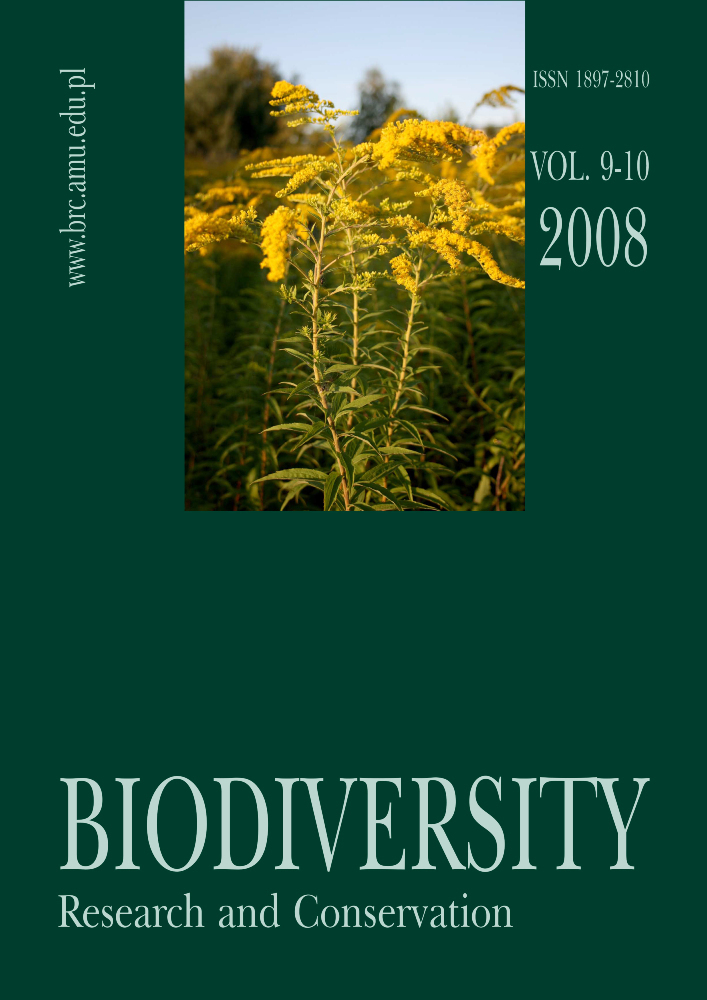Abstract
The distribution of invasive alien and expansive native vascular plant species in plant communities growing on fields in Slovakia was studied. Arable fields (cereals, perennial fodder crops, root, and stubbles) and 1-2-year abandoned fields were evaluated. The study was based on phytosociological data consisting of 486 relevés recorded in 2002-2008, from various parts of Slovakia. In the group of 371 vascular plant taxa recorded in the segetal communities (so-called weeds), 56 taxa are invasive or expansive species, representing 15% of total taxa. Among them, 21 taxa are invasive (10 neophytes and 11 archaeophytes), 10 are potentially invasive, 4 are frequently escaping from cultivation, 6 are occasionally escaping from cultivation, 5 species are naturalized, 8 are expansive native taxa, and 2 are data-deficient. The most frequent invasive or expansive weed species in the studied agrocoenoses were: Tripleurospermum perforatum, Cirsium arvense, and Veronica persica. Recorded species belong to 19 families, mostly to the Asteraceae, Chenopodiaceae, and Poaceae.
References
BARKMAN J. J., DOING H. & SEGAL S. 1964. Kritische Bemerkungen und Vorschläge zur quantitativen Vegetationsanalyse. Acta Bot. Neerl., Amsterdam 13: 394-419. DOI: https://doi.org/10.1111/j.1438-8677.1964.tb00164.x
BRAUN-BLANQUET J. 1964. Pflanzensoziologie. Grundzüge der Vegetationskunde. Ed. 3. 866 pp. Springer-Verlag, Wien-New York. DOI: https://doi.org/10.1007/978-3-7091-8110-2
DEYL M. 1964. Plevele polí a zahrad. 390 pp. Nakladatelství Československé akademie věd, Praha.
DOSTÁL J. & ČERVENKA M. 1992. Vel’ký kl’úč na určovanie vyšších rastlín II, pp. 776-1567. Slovenské pedagogické nakladatel’stvo, Bratislava.
FISCHER M. A., OSWALD K. & ADLER W. 2008. Exkursionsflora für Österreich, Liechtenstein, Südtirol. 3. Ed. 1392 pp. Biologiezentrum der OÖ Landesmuseen, Linz.
GOJDIČOVÁ E., CVACHOVÁ A. & KARASOVÁ E. 2002. Zoznam nepôvodných, inváznych a expanzívnych cievnatých rastlín Slovenska. Ochrana prírody, Banská Bystrica 21: 59-79.
HRIVNÁK R. & CVACHOVÁ A. 1997. Výskyt vybraných zavlečených druhov vyšších rastlín v južnej časti stredného Slovenska. In: P. ELIÁŠ (ed.). Invázie a invázne organizmy, Príspevky z ved. konferencie Nitra, 19-20 November 1996, pp. 136-143. SNK SCOPE, SEKOS, Bratislava.
CHYTRÝ M., PYŠEK P., TICHÝ L., KNOLLOVÁ I. & DANIHELKA J. 2005. Invasions by alien plants in the Czech Republic: a quantitative assessment across habitats. Preslia, Praha 77: 339-354.
JAROLÍMEK I., ZALIBEROVÁ M., MUCINA L. & MOCHNACKÝ S. 1997. Rastlinné spoločenstvá Slovenska 2. Synantropná vegetácia. 420 pp. Veda, Bratislava.
JEHLÍK V., HEJNÝ S., KROPÁČ Z., LHOTSKÁ M., KOPECKÝ K., SLAVÍK B. & SVOBODOVÁ Z. 1998. Cizí expanzivní plevele České republiky a Slovenské republiky. 510 pp.Academia, Praha.
KUBÁT K. (ed.). 2002. Klíč ke květeně České republiky. 930 pp. Academia, Praha.
LÍŠKA E. & HUNKOVÁ E. 2002. Škodlivost’ burín. In: E. LÍŠKA, K. ČERNUŠKO, E. HUNKOVÁ & P. OTEPKA. (eds.). Biológia burín, pp. 19-41. Slovenská pol’nohospodárska univerzita v Nitre, Nitra.
MARHOLD K. (ed.). 1998. Ferns and flowering plants. In: K. MARHOLD & F. HINDÁK (eds.). Checklist of non-vascular and vascular plants of Slovakia, pp. 333-687. Veda, Bratislava.
PYŠEK P. 1997. Compositae as invaders: better than the others? Preslia, Praha 69: 9-22.
PYŠEK P., SÁDLO J. & MANDÁK B. 2002: Catalogue of alien plants of the Czech Republic. Preslia, Praha 74: 97-186.
PYŠEK P., JAROŠÍK V., CHYTRÝ M., KROPÁČ Z., TICHÝ L. & WILD J. 2005. Alien plants in temperate weed communities: prehistoric and recent invaders occupy different habitats. Ecology 86: 772-785. DOI: https://doi.org/10.1890/04-0012
RABITSCH W. & ESSL F. 2006. Biological invasions in Austria: patterns and case studies. Biological Invasions 8: 295-308. DOI: https://doi.org/10.1007/s10530-004-7890-3
TERPÓ A. 1997. Invázne druhy pôvodných a synantropných biotopov v Mad’arsku. In: P. ELIÁŠ (ed.). Invázie a invázne organizmy, Príspevky z ved. konferencie Nitra, 19.-20. november 1996, pp. 81-90. SNK SCOPE, SEKOS, Bratislava.
TÖRÖK K., BOTTA-DUKÁT Z., DANCZA I., NÉMETH I., KISS J., MIHÁLY B. & MAGYAR D. 2003. Invasion gateways and corridors in the Carpathian Basin: biological invasions in Hungary. Biological Invasions 5: 349-356. DOI: https://doi.org/10.1023/B:BINV.0000005570.19429.73
URBISZ A. & URBISZ A. 2008. Species escaping from cultivation (ergasiophygophytes), noted in south-western part of the Silesian Upland (South Poland). Thaiszia-J. Bot., Košice 18 (Suppl. 1): 153-160.
License
Copyright © by Adam Mickiewicz University, Poznań, Poland, Department of Plant Taxonomy, 2008OPEN ACCESS




